Stratified polyhedral homotopy
Picking up witness sets on our way to isolated solutions
Tianran Chen
Department of Mathematics
Auburn University at Montgomery
January 4, 2023
AMS Special Session on Polynomial Systems, Homotopy Continuation and Applications
Joint Mathematics Meetings 2023
Boston, MA USA
Numerical algebraic geometry toolbox
Sommese & Wampler. Numerical algebraic geometry. In The mathematics of numerical analysis (Park City, UT, 1995), volume 32 of Lectures in Appl. Math., pages 749-763. Amer. Math. Soc., Providence, RI, 1996.
- Isolated and nonsingular zeros
- Witness sets for positive-dimensional components
- ...... (many many higher level data structures/algorithms)
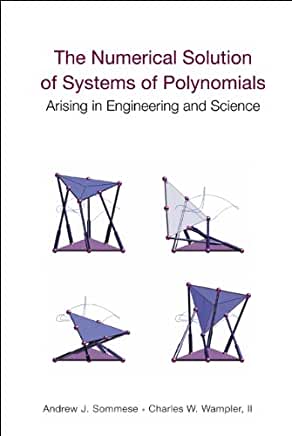
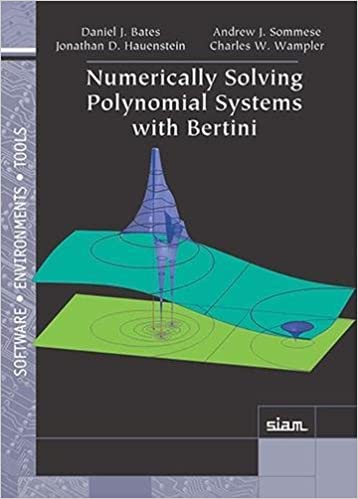
Also, an accessible introduction:
Hauenstein & Sommese.
What is numerical algebraic geometry?
J Symb Comput 79 (2017)
Goal
"Sample" points in non-isolated components as by-products of computing isolated zero set via polyhedral homotopy method.
Repurpose waste products from polyhedral homotopy method.
Polyhedral homotopy of Huber and Sturmfels
Huber & Sturmfels. A polyhedral method for solving sparse polynomial systems. Math Comput 64, 1541-1555 (1995).
To compute all $\mathbb{C}^*$-zeros of a (Laurent) polynomial system \[ f_i(\mathbf{x}) = \sum_{\mathbf{a} \in S_i} c_{\mathbf{a}} \mathbf{x}^{\mathbf{a}} \quad\text{for } i = 1,\ldots,n \] in $\mathbf{x} = (x_1,\ldots,x_n)$, we construct $H = (h_1,\ldots,h_n)$ \[ h_i (\mathbf{x}, t) = \sum_{\mathbf{a} \in S_i} (c_{\mathbf{a}} + \color{blue}{t c_\mathbf{a}^*}) \, \mathbf{x}^{\mathbf{a}} \, \color{blue}{e^{-M \omega_{\mathbf{a}} t}}. \]
- $c_{\mathbf{a}}^*$ are generic coefficients
- $\omega_{\mathbf{a}}$ are generic rational "lifting" values
- $M > 0$ is sufficiently large
Kim & Kojima. Numerical Stability of Path Tracing in Polyhedral Homotopy Continuation Methods. Computing (2004).
Lee, Li & Tsai. HOM4PS-2.0: a software package for solving polynomial systems by the polyhedral homotopy continuation method. Computing (2008).
\[ f_i(\mathbf{x}) = \sum_{\mathbf{a} \in S_i} c_{\mathbf{a}} \mathbf{x}^{\mathbf{a}} \quad\longrightarrow\quad h_i (\mathbf{x}, t) = \sum_{\mathbf{a} \in S_i} (c_{\mathbf{a}} + \color{blue}{t c_\mathbf{a}^*}) \, \mathbf{x}^{\mathbf{a}} \, \color{blue}{e^{-M \omega_{\mathbf{a}} t}}. \]
- $H(\mathbf{x},t) = 0$ defines smooth "solution paths" in $(\mathbb{C}^*)^n \times (0,1)$;
- These paths escape $(\mathbb{C}^*)^n$ near the starting point $t=1$ but be approximated via "mixed cells computation" & solving binomial systems...... (can be done).
- Standard path trackers can track them from $t=1$ to $t=0$ and reach all isolated $\mathbb{C}^*$-zeros of the target system.
Polyhedral homotopy
- The number of paths equals the Bernshtein-Kushnirenko-Khovanskii (BKK) bound.
- Optimal for computing isolated $\mathbb{C}^*$-zeros of generic systems.
- Stable cell method (Huber & Sturmfels) and Random constant deformation (Li & Wang) extend this method to isolated $\mathbb{C}$-zeros.
- PHCpack, Hom4PS-*, pHom, PSS, HomotopyContinuation.jl...
Can polyhedral homotopy compute non-isolated solutions?
Different approaches in the same direction:
- Verschelde. Polyhedral Methods in Numerical Algebraic Geometry. In Interactions of Classical and Numerical Algebraic Geometry, Contemporary Mathematics 496, pages 243-263, AMS 2009.
- Adrovic & Verschelde. Computing Puiseux Series for Algebraic Surfaces. In the Proceedings of ISSAC 2012.
- Bliss & Verschelde. Computing All Space Curve Solutions of Polynomial Systems by Polyhedral Methods. In the Proceedings of CASC 2016.
- Sommars & Verschelde. Computing Pretropisms for the Cyclic n-Roots Problem. In EuroCG 2016.
- ......
Non-isolated components
Zero set of a polynomial system may contain non-isolated components (i.e., positive-dimensional components).
- Non-isolated components contain infinitely many points (over $\mathbb{C}$)
- “Witness set” is the standard data structure for representing these components (Generic linear slices)
If a system has non-isolated zero component, then \[ \text{N.o. isolated zeros} \;\lneq\; \text{BKK bound} \;=\; \text{N.o. paths} \] Some paths are "wasted". (In a normal procedure)
Goal: Generate data structure like witness sets for non-isolated components from these "waste products".
A running example
Consider the polynomial system \[ F(x_1,x_2) = \begin{bmatrix} (x_1^2 + x_2^2 - 1)(x_1 + x_2 - 3) \\ (x_1^2 + x_2^2 - 1)(2x_1 - x_2 - 3) \end{bmatrix} \]

(Real picture only)
- Isolated nonsingular point $V_0$
- A (generically) reduced 1-dimensional component $V_1$
- There are singular points, which we will ignore for now
Can polyhedral homotopy method be used to compute both $V_0$ and $V_1$ from the same process?
As a parametrized system
\[ F = \begin{bmatrix} (x_1^2 + x_2^2 - 1)(x_1 + x_2 - 3) \\ (x_1^2 + x_2^2 - 1)(2x_1 - x_2 - 3) \end{bmatrix} \]
\[ F = \begin{bmatrix} x_1^3 + x_2 x_1^2 - 3 x_1^2 + x_2^2 x_1 - x_1 + x_2^3 - 3 x_2^2 - x_2 + 3\\ 2 x_1^3 - x_2 x_1^2 - 3 x_1^2 + 2 x_2^2 x_1 - 2 x_1 - x_2^3 - 3 x_2^2 + x_2 + 3 \end{bmatrix} \]
\[ F = \begin{bmatrix} c_1\;\,x_1^3 + c_2\;\,x_2 x_1^2 + c_3\;\,x_1^2 + c_4\;\,x_2^2 x_1 + c_5\;\,x_1 + c_6\; x_2^3 + \cdots \\ c_{10} x_1^3 + c_{11} x_2 x_1^2 + c_{12} x_1^2 + c_{13} x_2^2 x_1 + c_{14} x_1 + c_{15} x_2^3 + \cdots \end{bmatrix} \]
We will write it as \[ F(x_1,x_2 \;;\; \mathbf{c}) \] where $\mathbf{c}$ is the point in $\mathbb{C}^{18}$ whose coordinates are the coefficients.
This is a family of systems parametrized by points in $\mathbb{C}^{18}$.
This is not quite right: Grassmannian is the right space for the parameters.
Zeros under perturbation
What will happen to the zero set of $F(x_1,x_2 \;;\; \mathbf{c})$ if we replace $\mathbf{c}$ by a generic point $\mathbf{c}^*$ in the coefficient space $\mathbb{C}^{18}$?

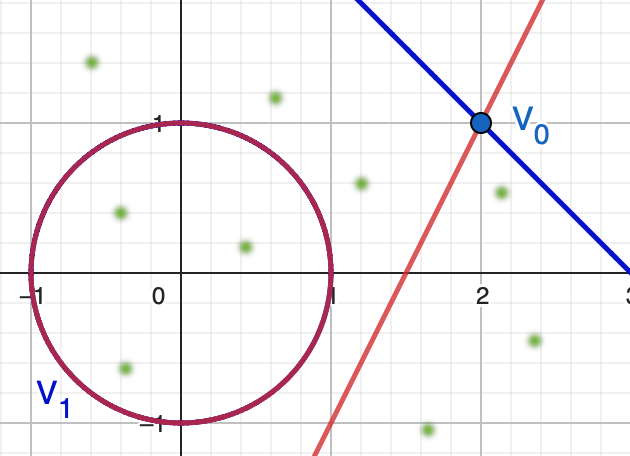
(Blurry dots are non-real zeros)
Zeros of $F(x_1,y_2 \;;\; \mathbf{c}^*)$
are isolated and nonsingular.
(All different from $V_0$ and $V_1$)
Sard's theorem: For almost all $\mathbf{c}^*$, zeros of $F(x_1,x_2 \;;\;\mathbf{c}^*)$ are isolated and nonsingular.
(Generalized Sard's Theorem) Chow, Mallet-Paret & Yorke. Finding zeroes of maps: homotopy methods that are constructive with probability one. Mathematics of Computation 32, no. 143 (1978)
Stratified perturbation
The coefficient space contains sets $C_2,C_1,C_0$ such that \[ \text{Whole parameter space} \;=\; \overline{C_2} \;\supset\; \overline{C_1} \;\supset\; \overline{C_0} \]
- $C_0 = \{ \mathbf{c} \}$ is just the original coefficient.
- $C_2$ contains almost all coefficient. For almost all $\mathbf{c}^*_2 \in C_2$, the zero set under perturbation $\mathbb{V}(F(x_1,x_2 \;;\; \mathbf{c}^*_2))$ consists of isolated and nonsingular points (Generalized Sard's theorem).
- For almost all $\mathbf{c}^*_1 \in C_1$, the zero set of $F(x_1,x_2 \;;\; \mathbf{c}^*_1)$ consists of isolated and nonsingular points, some of which are contained in $V_1$ (the 1-dimensional component of the original zero set).
Zeros at $\mathbf{c}^*_1$
For almost all $\mathbf{c}^*_1 \in C_1$, the zero set of $F(x_1,x_2 \;;\; \mathbf{c}^*_1)$ consists of 9 isolated and nonsingular points. (Blurry dots are non-real zeros)
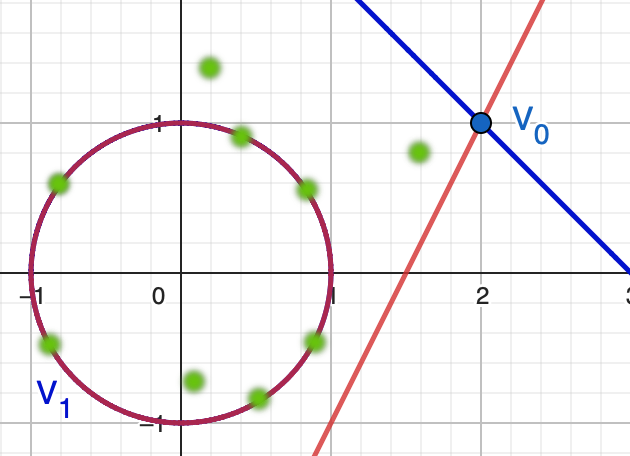
Among them 6 points are also smooth points of $V_1$.
I.e., when perturbed coefficients $\mathbf{c}^*_1$ is restricted to $C_1$, 6 of the 9 zeros of $F(x_1,x_2 \;;\; \mathbf{c}^*)$ are "stuck" inside the component $V_1$ of the original system.
They can be used as numerically well-behaved sample points for the 1-dimensional component $V_1$ of the original system.
Sample sets
New goal: Want to compute finite "sample sets" $W_0$ and $W_1$, s.t.
- $W_0$ contains all isolated nonsingular zeros of $F$.
- $W_1$ contains some smooth points of $V_1$.
Here, a point $\mathbf{x}$ of $V_1$ is considered "smooth" if the null space of $JF(\mathbf{x})$ is 1-dimensional.
Can we compute $W_0$ and $W_1$ from the same homotopy?
Stratified polyhedral homotopy
\[ F = \begin{bmatrix} c_1\;\,x_1^3 + c_2\;\,x_2 x_1^2 + c_3\;\,x_1^2 + c_4\;\,x_2^2 x_1 + c_5\;\,x_1 + c_6\; x_2^3 + \cdots \\ c_{10} x_1^3 + c_{11} x_2 x_1^2 + c_{12} x_1^2 + c_{13} x_2^2 x_1 + c_{14} x_1 + c_{15} x_2^3 + \cdots \end{bmatrix} \]
we construct the generalized polyhedral homotopy \[ H(x_1,x_2,\color{purple}{t_1},\color{blue}{t_2}) := \begin{bmatrix} (c_1\,\,\,+ \color{purple}{t_1 c_{1}^*}\, + \color{blue}{t_2 c_1^{**}}) x_1^3 \color{blue}{e^{-M \omega_{1} t_2}} + \cdots \\ (c_{10} + \color{purple}{t_1 c_{10}^*} + \color{blue}{t_2 c_{10}^{**}}) x_1^3 \color{blue}{e^{-M \omega_{10} t_2}} + \cdots \end{bmatrix} \]
and track the 9 solution path along the parameter path \[ \begin{aligned} (1&,1) &&\longrightarrow & (1&,0) &&\longrightarrow & (0&,0) \\ &\uparrow && & &\downarrow && & &\downarrow \\ \text{Starting } &\text{points} && & &W_1 && & &W_0 \end{aligned} \]
- $W_1$: contains 6 smooth points of $V_1$ of the original system;
- $W_0$: contains all isolate nonsingular zeros of the original system;
Isolated nonsingular zeros $W_0$ and sample sets for the 1-dim component $W_1$ can be computed from the same process.
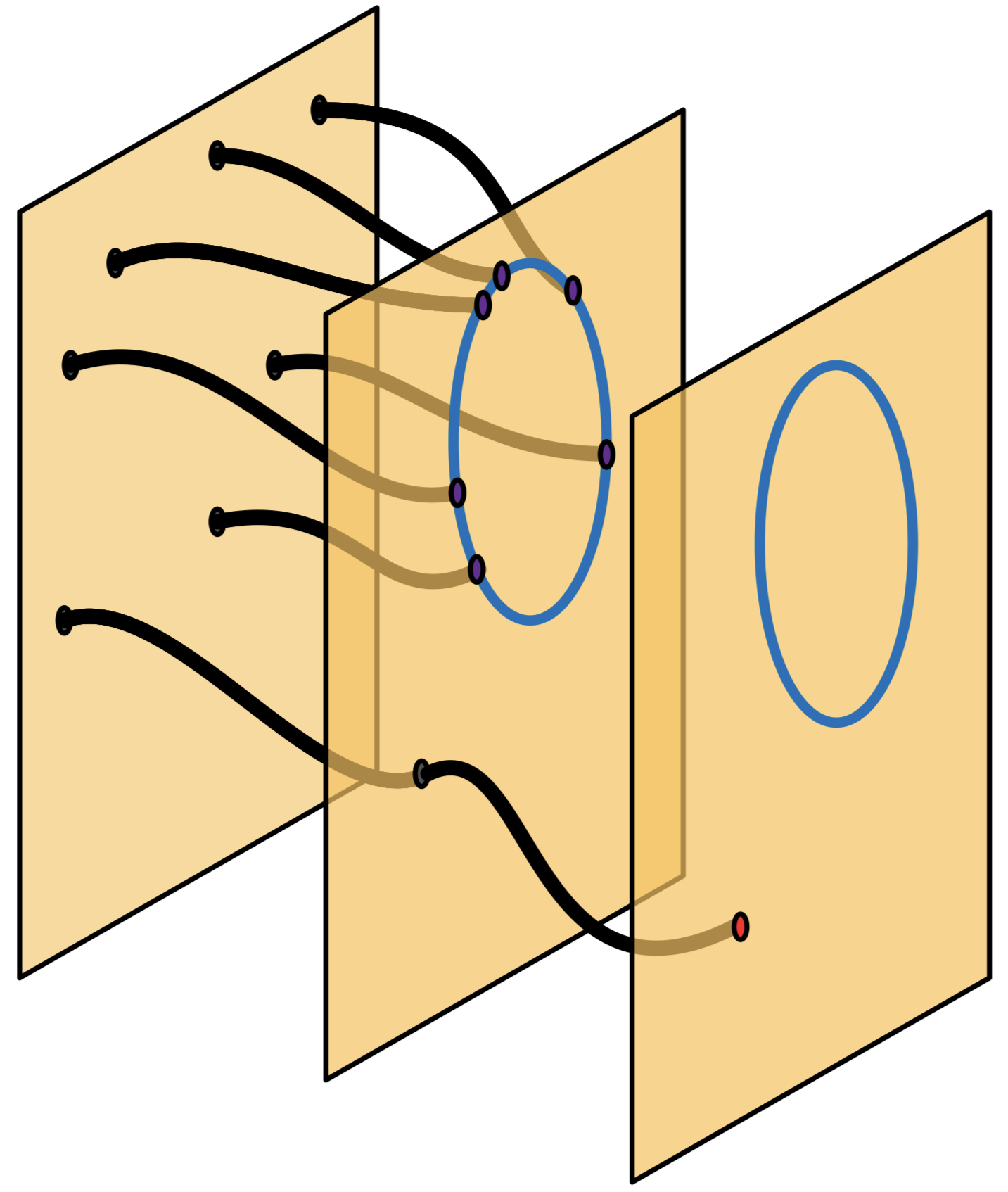
\[ \quad \quad \text{Starting points} \quad \quad W_1 \quad \quad W_0 \quad \text{(singular paths are ignored)} \]
General goal
Given a (Laurent) polynomial system $F = (f_1,\ldots,f_n)$ with \[ f_i(\mathbf{x}) = \sum_{\mathbf{a} \in S} c_{\mathbf{a}} \mathbf{x}^{\mathbf{a}} \] where $\mathbf{x} = (x_1,\ldots,x_n)$ and $S$ is their common support. We are interesting in computing the zero set of $F$ in the algebraic torus.
Numerically compute sample sets $W_{n-1},\ldots,W_1,W_0$ s.t.
- Each $W_d$ is contained in a $d$-dimensional component;
- Each $W_d$ contains at least one point from each (generically) reduced irreducible component;
- At each point $\mathbf{x} \in W_d$ , $\operatorname{rank} JF (\mathbf{x}) = n - d$;
Stratified polyhedral homotopy
For the (Laurent) polynomial system \[ f_i(\mathbf{x}) = \sum_{\mathbf{a} \in S} c_{\mathbf{a}} \mathbf{x}^{\mathbf{a}} \] we construct the homotopy \[ h_i = \sum_{\mathbf{a} \in S} ( c_{\mathbf{a}} + \color{purple}{ t_1(s) c_{\mathbf{a}}^{(1)} + \cdots + t_n(s) c_{\mathbf{a}}^{(n)} } ) \, \mathbf{x}^{\mathbf{a}} \, \color{purple}{e^{-M \omega_{\mathbf{a}} t_n(s)}} \]
- $M > 0$ is sufficiently large, $\omega_{\mathbf{a}}$ are generic “lifting” values
- $c_{\mathbf{a}}^{(k)}$ represent a generic perturbed coefficients in $C_k$
- $(t_1(s),\ldots,t_n(s))$ gives a path in the $t$-space passing through \[ (1,\ldots,1) \to (1,\ldots,1,0) \to \cdots \to (1,0,\ldots,0) \to (0,\ldots,0) \]
Certain vertices can be skipped if we know there won't be components of certain dimensions.
$C_k$'s
Each $C_k$ is the manifold consisting of coefficient choices created by adding generic "rank-$k$" perturbation to the original coefficients: \[ \mathbf{c}_k^* = \mathbf{c} + \boldsymbol{\epsilon}_k \] if we consider them as matrices. (Better to use Grassmannian)
\[ \overline{C}_n \supset \overline{C}_{n-1} \supset \cdots \supset \overline{C}_1 \supset \overline{C}_0 = \{ \mathbf{c} \} \]
Proposition. The solution paths defined by the homotopy \[ h_i(\mathbf{x},s) = \sum_{\mathbf{a} \in S} ( c_{\mathbf{a}} + \color{purple}{ t_1(s) c_{\mathbf{a}}^{(1)} + \cdots + t_n(s) c_{\mathbf{a}}^{(n)} } ) \, \mathbf{x}^{\mathbf{a}} \, \color{purple}{e^{-M \omega_{\mathbf{a}} t_n(s)}} \] pass through the "sample sets" \[ W_{n-1} \;\to\; W_{n-2} \;\to\; \cdots \;\to\; W_0 \] at $\mathbf{t}$-values \[ (1,\ldots,1,0) \to \cdots \to (1,0,\ldots,0) \to (0,\ldots,0) \] such that
- Each $W_d$ is contained in a $d$-dimensional component;
- Each $W_d$ contains at least one point from each (generically) reduced irreducible component;
- At each point $\mathbf{x} \in W_d$ , $\operatorname{rank} JF (\mathbf{x}) = n - d$;
These sample sets can be used as numerically well-behaved representations of positive-dimensional components.
Summary
With a minor modification of how perturbation of the coefficients is done, the (unmixed) polyhedral homotopy of Huber and Sturmfels can extract "sample sets" of non-isolate (positive-dimensional) components as by-products, using wasted paths.
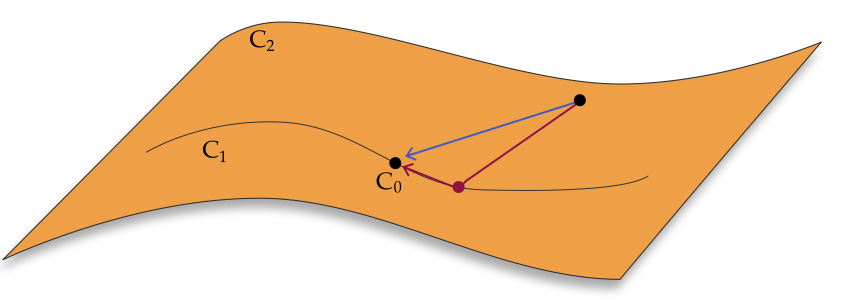
The number of paths to be tracked for $F = (f_1,\ldots,f_n)$ is \[ n! \operatorname{vol} ( \operatorname{conv}( \operatorname{Newt}(f_1) \,\cup\,\cdots\cup\, \operatorname{Newt}(f_n) )) \quad \text{(unmixed BKK bound)} \]
N.o. paths: Mixed vs. unmixed
\[ n! \operatorname{vol} ( \operatorname{conv}( \operatorname{Newt}(f_1) \,\cup\,\cdots\cup\, \operatorname{Newt}(f_n) )) \] Mixed volume $\longrightarrow$ volume
Easier?
Volume and mixed volume computations are both #P.
(Dyer, Gritzmann, Hufnagel. On The Complexity of Computing Mixed Volumes. SIAM J Comput 27, 1998)
\[ \begin{gathered} \text{General} \\ \text{volume computation} \end{gathered} \quad\approx\quad \begin{gathered} \text{Very special} \\ \text{mixed volume computation} \end{gathered} \]
Future work
- GPU accelerated implementation: (Proof-of-concept https://arxiv.org/abs/2111.14317)
- Irreducible decomposition via monodromy?
- Computing non-reduced components?
Thank you!
https://www.tianranchen.org/research/papers/stratified.pdf
http://arxiv.org/abs/2108.12875 (Volume equals mixed volume)
https://arxiv.org/abs/2111.14317 (GPU acceleration)
ti@nranchen.org

Research supported, in part, by National Science Foundation, and Auburn University at Montgomery via Grant-In-Aid and Professional Improvement Leaves programs.
